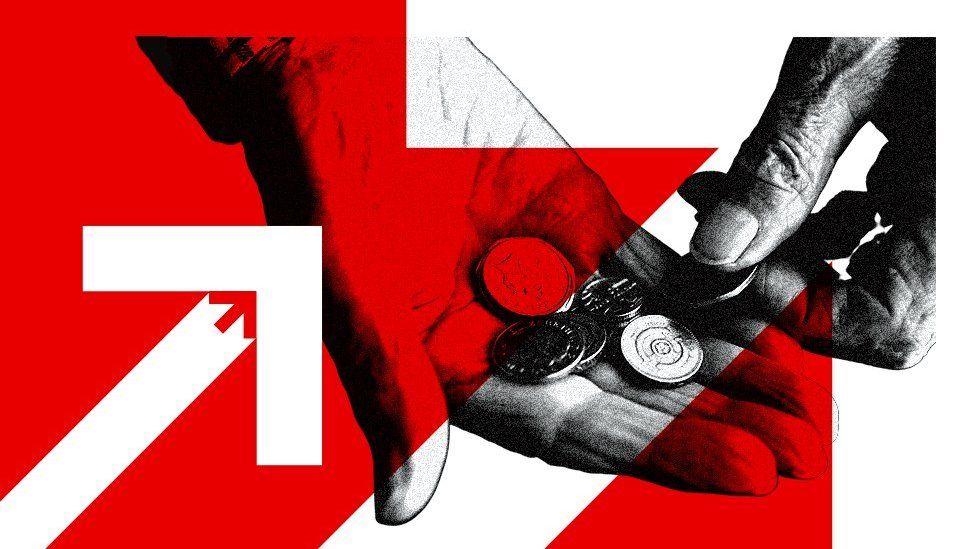The rate at which prices are rising remains high, driven by soaring food prices.

The rate at which prices are rising fell to 7.9% in the year to June, down from 8.7% in May.
Food inflation on items like sugar, olive oil and cooking sauces has come down, although remains high - at 17.3%.
To help slow price rises, the Bank of England has increased interest rates 13 times to 5% .
Inflation is the increase in the price of something over time.
If a bottle of milk costs £1 but £1.05 a year later, then annual milk inflation is 5%.
The Office for National Statistics (ONS) tracks the prices of hundreds of everyday items in an imaginary "basket of goods" .
The basket is constantly updated to reflect shopping trends, with the most recent changes adding frozen berries and removing alcopops.
Each month's inflation figure shows how much these prices have risen since the same date last year.
You can calculate inflation in various ways, but the main "headline" measure is the Consumer Prices Index (CPI).
CPI was 7.9% in the year to June , down from 8.7% in May and April.
Core inflation excludes the price of energy, food, alcohol and tobacco.
This measure was was 6.9% in June, down from 7.1% in May, which was the highest since 1992.
The Bank of England considers this number as well as the headline inflation figure when deciding whether to alter interest rates.
Soaring food and energy bills have helped drive inflation up.
Oil and gas were in greater demand as life got back to normal after Covid. At the same time, the war in Ukraine meant less was available from Russia , putting further pressure on prices.
The war also reduced the amount of grain available , pushing up global food prices.
This effect was compounded in the UK in February by a shortage of salad and other vegetables , which took food inflation to a 45-year high.
Alcohol prices in restaurants and pubs also rose.
The Bank of England has a target to keep inflation at 2%, but the current rate is well above that.
The traditional response to rising inflation is to put up interest rates .
This makes borrowing more expensive, and can mean some people with mortgages see their monthly payments go up. Some saving rates also increase.
When people have less money to spend, they buy fewer things, reducing the demand for goods and slowing price rises.
Businesses also borrow less, making them less likely to create jobs, and may cut staff.
In June, the Bank increased interest rates for the 13th time in a row , taking the main rate to 5%.
But when inflation is caused by factors such as global energy prices, action from the Bank of England may not be enough to slow it down.
Many people's pay isn't keeping up with rising prices.
Regular pay grew by 7.3% between March and May , compared to the same period a year earlier.
But when you take inflation into account, it actually fell by 0.8%.
Unions say wages should reflect the cost of living and many workers have been striking over pay.
However, the government argues big pay rises could push inflation higher because companies might increase prices as a result.
Lower inflation doesn't mean prices fall. It just means they rise less quickly.
The Bank of England has predicted inflation will drop to 5% by the end of 2023, rather than the 4% it had been anticipating.
Bank governor Andrew Bailey said it was "crucial that we see the job through" and get price rises back to the 2% target , because people "should trust that their hard-earned money maintains its value".
But he admitted that price inflation was being "more sticky than previously expected".
The Office for Budget Responsibility (OBR), which assesses the government's economic plans , previously predicted inflation would fall back to 2.9% by the end of the year.
In January, Prime Minister Rishi Sunak said halving inflation by the end of 2023 was one of the government's five key pledges .
Other countries have also been experiencing a cost-of-living squeeze.
Many of the reasons are the same - increased energy costs, shortages of goods and materials, and the fallout from Covid.
The annual inflation rate for countries which use the euro was estimated to be 5.5% in the 12 months to June, down from 6.1% in May.
The European Central Bank has also been increasing interest rates to try to bring eurozone inflation down. Its main rate is now 4% , the highest level for 22 years.
Inflation has also dropped back in the US. It was 3% in the 12 months to June, down from 4% in May , the 12th consecutive monthly fall.
But despite that, in July the US central bank put up its key interest rate again to between 5.25% to 5.5%. It is the 11th increase since early 2022, and also the highest level for 22 years.